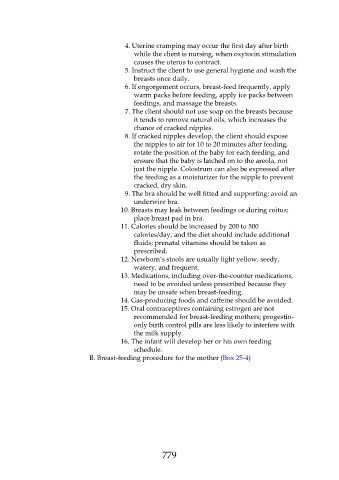Page 779 - Saunders Comprehensive Review For NCLEX-RN
P. 779
4. Uterine cramping may occur the first day after birth
while the client is nursing, when oxytocin stimulation
causes the uterus to contract.
5. Instruct the client to use general hygiene and wash the
breasts once daily.
6. If engorgement occurs, breast-feed frequently, apply
warm packs before feeding, apply ice packs between
feedings, and massage the breasts.
7. The client should not use soap on the breasts because
it tends to remove natural oils, which increases the
chance of cracked nipples.
8. If cracked nipples develop, the client should expose
the nipples to air for 10 to 20 minutes after feeding,
rotate the position of the baby for each feeding, and
ensure that the baby is latched on to the areola, not
just the nipple. Colostrum can also be expressed after
the feeding as a moisturizer for the nipple to prevent
cracked, dry skin.
9. The bra should be well fitted and supporting; avoid an
underwire bra.
10. Breasts may leak between feedings or during coitus;
place breast pad in bra.
11. Calories should be increased by 200 to 500
calories/day, and the diet should include additional
fluids; prenatal vitamins should be taken as
prescribed.
12. Newborn’s stools are usually light yellow, seedy,
watery, and frequent.
13. Medications, including over-the-counter medications,
need to be avoided unless prescribed because they
may be unsafe when breast-feeding.
14. Gas-producing foods and caffeine should be avoided.
15. Oral contraceptives containing estrogen are not
recommended for breast-feeding mothers; progestin-
only birth control pills are less likely to interfere with
the milk supply.
16. The infant will develop her or his own feeding
schedule.
B. Breast-feeding procedure for the mother (Box 25-4)
779

